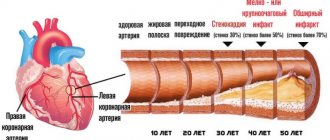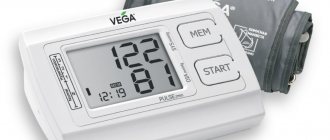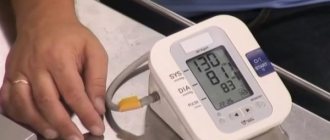Blood pressure parameters are the sum of two numbers. The upper one is called the systolic value, and the lower one is called the diastolic value. Each of them is consistent with a certain norm, depending on the age category of the person. Like any physical phenomenon, the force of the blood flow pressing on the muscle layer of blood vessels can be measured. These indicators are recorded using a scale with divisions on the pressure gauge. The marks on the dial correspond to a certain measure of calculation. In what units is blood pressure measured? To answer this question, we need to look at the history of the first tonometers.
What units are used and why
Pressure is a physical quantity. It must be understood as a certain force that acts on a certain area of a certain area at a right angle. This value is calculated according to the International System of Units in pascals. One pascal is the effect of a perpendicularly directed force of one newton per square meter of surface. However, when using a tonometer, different units are used. How is blood pressure measured in blood vessels?
The readings on the scale of a mechanical pressure gauge are limited to digital values from 20 to 300. There are 10 divisions between adjacent numbers. Each of them corresponds to 2 mm Hg. Art. Millimeters of mercury are the units for measuring blood pressure. Why is this particular measure used?
The first sphygmomanometer (“sphygmo” means “pulse”) was mercury. He studied the force of blood pressing on blood vessels using a column of mercury. The substance was placed inside a vertical flask, graduated with millimeter notches. Under the pressure of the air flow pumped by a rubber bulb into a hollow, inelastic cuff, the mercury rose to a certain level. Then the air was gradually released, and the column in the flask descended. Its position was recorded twice: when the first tones were heard, and when the last pulsations disappeared.
Modern tonometers have been working for a long time without the use of a dangerous substance, but blood pressure is measured traditionally, in millimeters of mercury, to this day.
Measuring devices
Blood pressure measuring devices are available to everyone. To measure it, a sphygmomanometer, or tonometer, is used.
Currently, two types are common:
- mechanical device;
- electronic device.
The mechanical device does not produce ready-made values, but is more accurate. Consists of a pressure gauge with a dial, a rubber bulb and a fabric cuff. The pulsation is heard by a person through a stethoscope while deflating the cuff, which is manually adjusted using a valve on the bulb. The pressure gauge can communicate with the bulb through the cavity of the cuff or directly.
Electronic tonometers determine pressure independently and are divided into:
- semi-automatic;
- automatic.
In a semi-automatic tonometer, instead of a pressure gauge, there is a display for displaying indicators. Air is also pumped into the cuff manually using a bulb.
Automatic blood pressure monitors carry out the entire procedure independently after pressing a button. The pump for pumping air is built into the body of the device. In addition to blood pressure, the display shows pulse data. There are wrist (simulating a wristwatch) and automatic shoulder blood pressure monitors. Wrist pressure is not measured in medical institutions, as it does not provide accurate information.
When choosing a sphygmomanometer, you need to pay attention to the size of the cuff. It should correspond to the circumference of the shoulder (less often the hip) or be as close as possible to the first number of the size indicated on the cuff through the dash. All pressure gauges should be checked and adjusted annually.
What do the numbers determined by the tonometer mean?
The blood pressure value is represented by two numbers. How to decipher them? The first, or top, reading is called systolic. The second (lower) is diastolic.
Systolic pressure is always higher and indicates the force with which the heart pumps blood from its chambers into the arteries. Occurs at the time of myocardial contraction and is responsible for the delivery of oxygen and nutrients to the organs.
The diastolic value is equal to the resistance force of the peripheral capillaries. It is formed when the heart is in the most relaxed state. The force of the vascular walls acting on red blood cells allows them to return to the heart muscle. The force of capillaries pressing on the blood flow, which occurs during diastole (rest of the heart), largely depends on the functioning of the urinary system. Therefore, this effect is often called renal.
When measuring blood pressure, both parameters are very important; together they ensure normal blood circulation in the body. To ensure that this process is not disrupted, the tonometer values must always be within acceptable limits. For systolic (heart) pressure, the generally accepted norm is 120 mmHg. Art., and for diastolic (renal) - 70 mm Hg. Art. Minor deviations in one direction or another are not recognized as pathology.
Normal pressure limits:
- Slightly underestimated: 100/65-119/69.
- Standard rate: 120/70-129/84.
- Slightly high: 130/85-139/89.
If the tonometer produces an even lower value (than in point one), this indicates hypotension. If the numbers are persistently elevated (above 140/90), a diagnosis of hypertension is made.
Based on the identified pressure parameters, the disease can belong to one of three degrees:
- 140/90-159/99 are 1st degree values.
- 160/100-179/109 – 2nd degree indications.
- Anything above 180/110 is already the 3rd degree of the disease.
The easiest of them is considered to be the first degree. With timely treatment and compliance with all doctor’s recommendations, it is cured. The third poses the greatest danger; it requires constant use of special pills and threatens human life.
Types of measuring instruments
When examined with a device for measuring blood pressure, the indicator of the brachial and carpal arteries is studied. Measurements are recorded in two numbers; the base values are 120/80. Permissible deviations are usually called the indicator +/- 10 units. rt. Art. The first (upper indicator) is the level of systolic pressure (during the period of maximum contraction of the heart muscle). Lower (diastolic) is determined at the minimum level of contraction.
To carry out measurements, 3 types of tonometers are used:
- Mechanical devices allow you to accurately determine the patient's pressure level, but require skill in use, good hearing and vision. Price-wise they are loyal.
- Semi-automatic are easy to use and use little energy. May have a heart rate measurement function. More expensive than mechanical ones.
- Automatic ones have several functions, remember the indicators of several measurements, a “guest” mode is possible, and measure pulse and arrhythmia. The cost of the devices depends on the set of functions. These medical devices are available in two types: shoulder and wrist.
Mechanical
Mechanical devices for measuring pressure (sphygmomanometers) are recognized as the most accurate; the devices are recommended by WHO for medical institutions.
The design of the devices requires certain skills in taking measurements. The most accurate values are those obtained by measuring blood pressure by another person.
The design of the device is traditional: an inflated cuff, a built-in pressure gauge, a bulb, an air release screw, and a stethoscope.
About the measurement technique
When studying the indicators with a device for measuring blood pressure in a person, the cuff is fixed on the shoulder, and the stethoscope is applied to the artery on the elbow. Then the air is pumped in with a bulb, and then gradually released using a special valve. The appearance of a pulse is the upper indicator of blood pressure, and the disappearance is the lower one.
There is no need to talk during the measurement; the limb should lie comfortably on the table. The patient sits motionless on a chair. The cuff is fixed 2 cm above the elbow.
Advantages and disadvantages
Among the advantages of mechanical devices for measuring pressure:
- accuracy of readings;
- low cost (inexpensive);
- the ability to take measurements under any conditions (no batteries or other power sources required).
See also Where to put mustard plasters for high blood pressure?
Disadvantages include the need for measurement skills and good hearing.
Popular models
The most purchased mechanical tonometers in 2020 in the pharmacy chain were:
- LD-71A. The device consists of a metal pressure gauge built into a durable nylon cuff with a seamless pneumatic chamber, a needle air valve, and a metal stethoscope. The parts are packed in a nylon bag. This is the most accurate tonometer, the device error is less than 4 mm Hg. Art. Cost from 500 rub.
- CS MEDICA/CS HEALTHCARE CS-105. A hand-held tonometer with a built-in stethoscope, designed for long-term, frequent use; the device can be taken on the road. It consists of a metal pressure gauge and a bulb with a metal screw; there is a bracket on the cuff that allows you to secure it evenly on your arm independently. The pear is equipped with a special filter that does not allow dust to pass through. Cost - from 530 rubles.
Semi-automatic
Semi-automatic blood pressure meters consist of a cuff, a bulb, and an electronic chip. When measuring pressure, a sensitive electronic sensor detects heart sounds using an oscilloscope and transmits the readings to the monitor screen. The device is activated by one button.
How to measure pressure?
To measure pressure, air is pumped into the cuff using a bulb and then slowly released, as in a mechanical tonometer. The electronics will count the vibrations and display the result on the display. The device is easy to operate, the numbers on the screen are large, and you don’t need good hearing to listen to tones. The electronics are powered by a built-in battery; its charge consumption is economical, since an electric pump is not used.
Advantages and disadvantages
Among the advantages of semi-automatic tonometers for measuring blood pressure, users name several:
- simply measure blood pressure without outside help;
- no additional skills required;
- You do not need to have good hearing and vision to perform the procedure.
Among the negative aspects - it is difficult for older people to bleed air (their fingers are less mobile), there are no children's cuff models, and the cost is higher.
Popular models
- BP A 50. The model has a cuff with a built-in electronic stethoscope, a bulb and a display with large numbers. The device is equipped with a special recognizer for detecting arrhythmia; it will show if the patient moved or fastened the cuff incorrectly during the measurement. Cost - from 1490 rubles.
- Omoron C1 is equipped with a bulb, a cuff and a display. Shows pressure measurement results. To start working, just press the button and pump in air. Price from 1350 rub.
Slot machines
Automatic blood pressure measuring devices come in a wide range. The devices operate on batteries and mains. Among such devices there are shoulder and wrist devices. Electronics can keep a log of measurements, record readings for several patients (for each individually); many have a built-in “guest” function, which allows you to measure pressure separately (for example, a neighbor) and not record the data in the log of readings. There are models that measure the pulse and signal arrhythmia, issuing warnings that the phenomenon is observed too often.
See also Pressure indicators during myocardial infarction
How to measure pressure?
To measure blood pressure, attach the cuff and press a button. Among the functions of automatic devices for measuring human pressure are the following:
- using an electric pump, the device will pump air into the cuff to the desired level;
- will measure pressure;
- will record blood pressure, pulse, and detect arrhythmia;
- will display data on the screen and enter information into a special journal.
Advantages and disadvantages
Among the positive aspects of electronic tonometers are:
- ease of use;
- extensive set of functions;
- presence of large numbers on the display.
The disadvantages include the high price, the need to frequently replace batteries, the presence of significant errors if the cuff is incorrectly fastened, high sensitivity, pulse irregularity, some models for older people are difficult to use, and if the shoulder circumference is too large or small, significant measurement errors are possible.
Range
Popular models include the following:
- OMRON M3 EXPERT. A smart device for home use with a display and a shoulder cuff, runs on batteries, and has an AC adapter. Evaluates the regularity of the pulse. If your heart rhythm is abnormal, a special icon appears on the display. A different icon indicates that the cuff is not properly secured. The previous digits are stored in the device's memory and are available for viewing. Turns off after measurement. However, the device is difficult to understand and is difficult for older people to understand. Cost - from 2600 rubles.
- BP A 90. Device for the road, home. Compact, has the functions of storing blood pressure and pulse measurements, reports the battery charge level, and turns itself off after the end of the operation. Has only one button. Cost from 1250 rub.
- BP A100 LIGHT multifunctional tonometer for measuring blood pressure and pulse. It remembers 30 measurements, detects arrhythmia, and has a special function that allows you to insert a photo onto the display. There is a sound signal when the cuff is inflated, which makes it possible for people with low vision to use the device. It has one button, but requires certain skills to operate the three-line screen. The large cuff allows use for overweight people. Cost from 1600 rub.
- UB-201. Easy to use wrist tonometer. Lightweight, economical (one set of batteries is enough for 400 measurements). It has a three-line screen and is controlled by one button. The device is recommended for use by people under 40 years of age; only under this condition will it show accurate results. Cost - from 1350 rubles.
See also: Relationship between high blood pressure and diarrhea?
Blood pressure indicators: depending on age
Standard figures are averages. They are not very often found in their generally accepted form. The tonometer values of a healthy person constantly fluctuate because the conditions of his life, physical well-being and mental state change. But these fluctuations are insignificant for the full functioning of the body.
Indicators of pressure in the arteries also depend on what age category the man or woman belongs to. From the newborn period to old age, the needles of the measuring instrument tend to show increasingly higher numbers.
Table: norms of systolic and diastolic pressure corresponding to a certain age and gender.
| Number of years | 0-1 | 1-10 | 11-20 | 21-30 | 31-40 | 41-50 | 51-60 | 61-70 | 71-80 | 81-90 |
| Systolic indicators, women | 95 | 103 | 116 | 120 | 127 | 137 | 144 | 159 | 157 | 150 |
| Diastolic indicators, women | 65 | 70 | 72 | 75 | 80 | 84 | 85 | 85 | 83 | 79 |
| Systolic parameters, male gender | 96 | 103 | 123 | 126 | 129 | 135 | 142 | 145 | 147 | 145 |
| Diastolic indicators, male gender | 66 | 69 | 76 | 79 | 81 | 83 | 85 | 82 | 72 | 78 |
As can be seen from the table, gender also matters. It has been noted that women under 40 years of age have lower blood pressure than men. After this age, the opposite phenomenon occurs. This difference is explained by the action of specific hormones that maintain the good condition of the circulatory system of the fair sex during the childbearing period. With the onset of menopause, hormonal levels change and vascular protection weakens.
The parameters of measured pressure in older people also differ from the generally accepted norm. They are usually taller. But at the same time, people feel good about these indicators. The human body is a self-regulating system, and therefore a forced decrease in usual values can often lead to deterioration in health. Vessels in old age are often affected by atherosclerosis, and in order to fully supply the organs with blood, the pressure must be increased.
You can often hear a combination such as “working pressure”. This is not synonymous with the norm, simply due to physiological characteristics, age, gender and health status, each person requires “their own” indicators. With them, the body’s vital functions proceed in optimal conditions, and a woman or man feels cheerful and active. The ideal option is when the “working pressure” coincides with generally accepted standards or does not differ much from them.
To determine the optimal tonometer indicators, depending on age and weight, you can use special calculations called the Volynsky formula:
- 109+(0.5 *number of years)+(0.1*weight taken in kg) – systolic value;
- 63+(0.1*years lived)+(0.15*weight in kg) – diastolic parameters.
It is advisable to carry out such calculations for people from 17 to 79 years old.
Measuring rules
When measuring blood pressure, certain rules must be followed. Any deviations from them may lead to unreliable results. And this can lead to an incorrect diagnosis of a person’s condition.
Today, there are several ways to measure the indicator. All of them, without exception, are measured in mmHg. The simplest method is to use a cuff and a blood pressure monitor. Here it is necessary to follow the correct sequence of actions. The main thing is to apply the cuff and listen to the heart sound. It is not so easy to carry out the procedure on your own; for this, a person must have certain experience and special training.
The easiest way to determine blood pressure is to use an electronic tonometer.
Find out your risk level for heart attack or stroke
Take a free online test from experienced cardiologists
Testing time no more than 2 minutes
Blood pressure is measured in millimeters of mercury and is always given as two numbers. These are indicators of systolic (upper) and diastolic (lower) pressure.
Features of the functioning of the human cardiovascular system can be monitored by knowing how blood pressure is measured and regularly checking the state of health. Blood pressure, as is known, varies slightly depending on the time of day for each person and varies greatly in people suffering from vegetative-vascular dystonia and hypertension. In this regard, it is important to monitor the level of the indicator.
It is important to understand how and in what way blood pressure is measured. Most people find out the value of their blood pressure using a special device - a tonometer or, as it is also called, a sphygmomanometer. Devices today are available in different types.
However, if surges occur quite often, it is best to see a doctor and get registered. In this case, it will be necessary not only to monitor the blood pressure, but to undergo treatment in order to prevent its sudden changes.
It is impossible to know your blood pressure level without knowing in what units blood pressure is measured. When determining blood pressure, millimeters of mercury are used. The units of measurement are indicated on the preparation to measure its value.
Of course, speaking about the process, it is important to note the basic rules in accordance with which the procedure must be carried out:
- one hour before the procedure, it is not recommended to drink alcohol, coffee, strong tea, smoke, or use adrenergic agonists;
- Do not measure blood pressure after excessive physical exertion;
- the procedure must be carried out in comfortable conditions;
- the blood pressure value will be elevated if measured in a person under stress;
- first - the toilet, then - the blood pressure monitor;
- It is important to relax the hand to which the device is connected and keep it in a comfortable position;
- do not move during the process.
If a person monitors blood pressure regularly, measurements should be taken twice every day, and at the same time. To find out the most accurate values of the measured indicator, you should do this three times, the interval is 3-5 minutes.
If the measurement is carried out for the first time, blood pressure must be determined in both arms. In the future, measure it with a larger value.
There are different types of devices, but the main components of each tonometer are the following elements:
How to measure your blood pressure correctly
To improve measurement accuracy it is necessary:
- Before starting the diagnosis, sit in a calm environment for 5 minutes;
- do not smoke for 30 minutes before diagnosis;
- Blood pressure is best measured while sitting. In this case, the patient’s hand is in a relaxed state and free from clothing. There should be no scars or cuts on the skin in the area of the brachial artery, as well as swelling or a hemodialysis fistula;
- the elbow bend is placed at the level of the heart; to do this, place the hand on the table just above the lumbar region;
- The tonometer cuff is placed on the shoulder so that its lower border is two fingers above the level of the elbow. The cuff itself is attached quite tightly, and it should not cause pain;
- Blood pressure is determined twice, with an interval of 2 minutes. In the case when the readings diverge by more than 5 mmHg. column, an additional measurement is taken. Based on the data obtained, its average value is derived.
For the first measurement, it is recommended to take readings from both hands. After the initial reading, the pressure is checked on the arm where its level is higher. A more difficult task is to calculate it when the heart rhythm is disturbed. In this case, it is better to entrust the readings to a medical professional.
When diagnosed with hypertension, it is recommended to measure blood pressure twice a day, morning and evening (at 21:00 - 22:00). It is also recorded for any signs of deterioration in the patient’s condition. The obtained indicators are recorded in a special recording diary for further consultation with the attending physician.
General pressure formula
From the classical definition of what pressure is, a general formula for calculating it can be derived. It will look like this:
P = F/S
Where F is the pressure force, and S is the surface area on which it acts. That is, in other words, the formula for finding pressure is the force acting on a certain surface, divided by the area of this very surface.
As can be seen from the formula, when calculating pressure the following principle always applies: the smaller the space affected by the force, the greater the amount of pressing force on it and vice versa.
This can be illustrated with a simple real-life example: it is easiest to cut bread with a sharp knife, because a sharp knife has a sharpened blade, that is, the surface area S from the formula is minimal, which means that the pressure of the knife on the bread will be maximally equal to the applied force F of the person holding the knife . But cutting bread with a dull knife is more difficult, since its blade has a large surface area S, and the pressure of the knife on the bread will be less, which means that in order to cut yourself a piece of bread you need to apply a greater amount of force F.
The general formula for pressure, in fact, perfectly describes the formula for the pressure of a solid body.
Pressure fluctuation
Research has shown that the pressure value is not constant. It is subject to vibrations that are called Mayer waves. They were discovered by the German Sigmund Mayer at the end of the 19th century. Based on the research results, the scientist concluded that in humans the oscillation frequency is approximately 0.1 Hz or 5-6 times per minute. Mayer waves are also characteristic of animals, such as rabbits and rats, but their rates are 3-4 times higher.
It was experimentally established that pressure fluctuations are constant and do not change depending on age, weight or gender. However, their amplitude may increase due to the activity of the sympathetic division of the autonomic nervous system. The only question that remains unresolved is the cause of the occurrence of Mayer waves, but research in this direction is underway.
Atmosphere pressure
The atmosphere is a gas, or more precisely, a mixture of gases, which is held near the Earth due to gravity. The atmosphere passes into interplanetary space gradually, and its height is approximately 100 kilometers.
How do we understand the expression “atmospheric pressure”? Above every square meter of the earth's surface there is a hundred-kilometer column of gas. Of course, the air is clear and pleasant, but it has a mass that presses on the surface of the earth. This is atmospheric pressure.
Normal atmospheric pressure is considered to be 101325 Pa. This is the pressure at sea level at 0 degrees Celsius. 766 high exerts the same pressure at the same temperature on its base .
The higher the altitude, the lower the atmospheric pressure. For example, at the top of Mount Chomolungma it is only one-fourth of normal atmospheric pressure.
Everest. At its top the pressure is 4 times less than at the foot
Blood pressure (BP) assessment
To assess blood pressure levels, the World Health Organization (WHO) classification is used.
Classification of arterial hypertension by blood pressure level
| Systolic blood pressure (mm Hg) | Diastolic blood pressure (mm Hg) | |
| Norm | ||
| Optimal blood pressure** | ||
| Normal blood pressure | ||
| Increased normal blood pressure | ||
| Arterial hypertension | ||
| 1st degree (“soft”) | ||
| 2nd degree (moderate) | ||
| 3rd degree (severe) | ||
| Border | ||
| Isolated systolic | ||
* If systolic BP and diastolic BP are in different categories, the higher category is assigned.
** The risk of cardiovascular complications and mortality is the lowest.
The terms “mild”, “borderline”, “severe”, “moderate” given in the classification characterize only the level of blood pressure, and not the severity of the disease itself.
Blood pressure standards: what they are measured in and how they are deciphered
Blood pressure, without exaggeration, is one of the main indicators of health. To determine physiological abnormalities, standards existing in medical practice are required. The starting point is considered to be 120 by 80 mmHg. Art. This is the average figure for an adult, which identifies pathological disorders of the cardiovascular system.
Most doctors agree that this arterial indicator is quite arbitrary. Comfortable numbers are different for each person. In everyday life they are called “working pressure”, at which a person feels good. In this case, the values on the tonometer may differ significantly from the standard 120/80.
Blood pressure depends on many factors, primarily age. Therefore, the basis of medical standards is the age criterion:
- in newborns the pressure is usually 60 to 40 mmHg. Art.;
- in children from 1 month to 3 years it ranges from 90 to 45 to 105 to 65;
- up to 5–6 years it remains at the level of 110/60 mmHg. Art.;
- in the period between 6 and 12 years – 110–120/60–70;
- in adolescence it can vary from 110 to 70 to 130 to 80;
- from 14–16 years old it approaches an adult – 120–125/75-80;
- after 40 years it increases to 130–135 by 80–85;
- from 60–65 years old – 135 to 85 mm Hg. Art. and higher.
The norm defines indicators that doctors consider safe for humans.
Depending on these average indicators, a diagnosis of hypotension (below 100 by 60) and hypertension (above 140 by 90) is made. In this case, there are usually unpleasant symptoms in the form of headaches, dizziness, insomnia, and rapid heartbeat, which force you to go to the doctor. It is important to listen to how you feel and measure your blood pressure so that complications do not develop.
Pressure in liquids
If in a solid body pressure is transmitted in the direction of the force, then in liquids and gases, according to Pascal’s law, “ any pressure exerted on a liquid or gas is transmitted in all directions without changes
».
Let's fill a ball with tiny holes connected to a narrow tube in the form of a cylinder with liquid. Let's fill the ball with liquid, insert a piston into the tube and start moving it. The piston presses on the surface of the liquid. This pressure is transmitted to every point in the fluid. Liquid begins to pour out of the holes in the ball.
Filling the ball with smoke, we will see the same result. This means that in gases pressure is also transmitted in all directions.
A liquid, like any body on the surface of the Earth, is affected by gravity. Each layer of liquid in the container creates pressure with its weight.
This is confirmed by the following experience.
If you pour water into a glass vessel with a rubber film instead of a bottom, the film will bend under the weight of the water. And the more water there is, the more the film will bend. If we gradually immerse this vessel with water in another container, also filled with water, then as it descends the film will straighten. And when the water levels in the vessel and the container are equal, the film will straighten out completely.
At one level, the pressure in the liquid is the same. But with increasing depth it increases, since the molecules of the upper layers exert pressure on the molecules of the lower layers. And they, in turn, put pressure on the molecules of the layers located even lower. Therefore, at the lowest point of the container the pressure will be highest.
Pressure at depth is determined by the formula:
p = ρ g h
,
where p
— pressure (Pa);
ρ
— liquid density (kg/m3);
g
— free fall acceleration (9.81 m/s);
h
— height of the liquid column (m).
From the formula it is clear that pressure increases with increasing depth. The lower a submersible goes in the ocean, the more pressure it will experience.
What is blood pressure, its types
Blood pressure is the pressure of blood on the walls of blood vessels as it is pumped by the heart. Blood volume per unit of time is the determining indicator. With each heartbeat, the blood flow travels through different vessels, therefore venous, capillary, and intracardiac pressure are released. But it is the arterial criterion that is accepted as determining health.
To measure a person's blood pressure, heart rate plays a leading role. It is responsible for blood circulation between the heart and brain. To some extent, the indicators are affected by the quality of blood, the condition of blood vessels, and concomitant functional disorders.
Blood pressure is expressed in two values, which are shown by the numbers:
- systolic (upper) pressure - the moment the heart muscle contracts and blood is released into the arteries;
- diastolic (lower) – the moment of myocardial relaxation with minimal peripheral resistance.
Blood circulating through the aorta continuously presses on the inner surface of the vessels
In a normal situation, the upper indicator is greater than the lower one. The difference between them is called pulse pressure and is 30–50 units. With pathological changes in the circulatory system, the numbers can be completely different.
Blood pressure measurements should be taken at any age. The procedure is quite simple, but very important for preventing hypertension, heart failure, stroke, heart attack and maintaining good health.
Why do you need to measure blood pressure?
Each person's blood pressure limits are individual. They can differ from the norm by 5-10 units, and at the same time you will feel excellent. But there are factors that cause pressure “jumps”. In this case, the person complains of malaise, headaches, hearing loss and blurred vision. Pressure instability leads to increased stress on the myocardium. The heart works in an accelerated mode, which causes pain, tachycardia, and further progression of the disease - heart failure, left ventricular hypertrophy.
In most cases, hypertension is asymptomatic. Sensitive patients may experience:
- facial hyperemia;
- panic attack;
- nervous excitement;
- sweating;
- pain in the heart and back of the head.
To make a correct diagnosis, you need to use a tonometer and measure your blood pressure. These symptoms cannot be ignored. A negligent attitude towards one's health leads to complications in the form of a hypertensive crisis, heart attack, and cerebral hemorrhage.
Hypertension
In some cases, hypotension can be dangerous to health. Low blood pressure numbers lead to insufficient nutrition of the brain. This occurs due to the decreased tone of the vessels.
Hypotension
Important! Blood pressure is measured for self-monitoring. You need to find out the blood pressure limits in the morning and evening, in order to prevent the numbers from exceeding, take medications on time, because it is at this time that “jumps” in blood pressure are most often observed.










